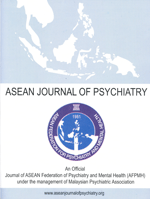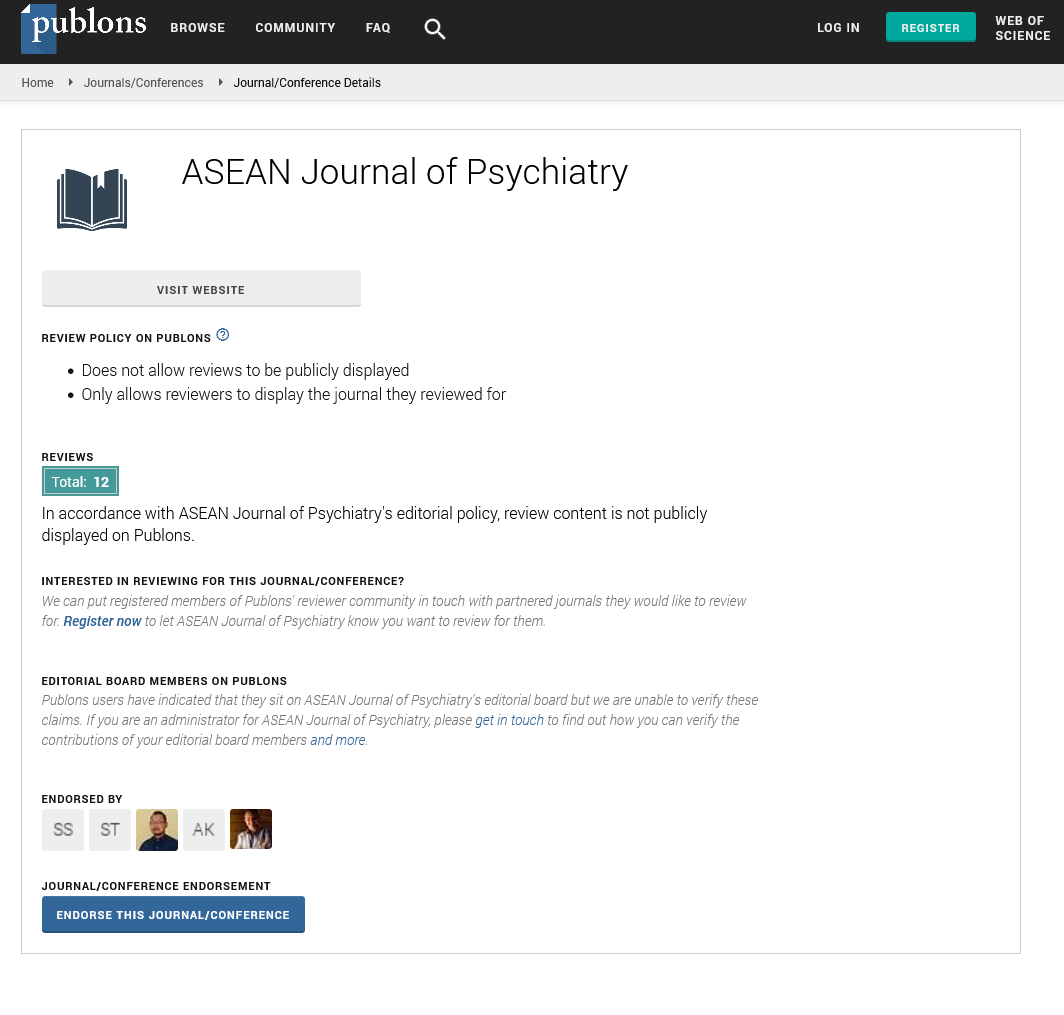THE DIFFERENCE BETWEEN JUDGMENT STYLES AMONG DEPRESSIVE AND NON-DEPRESSIVE INDIVIDUALS: A VALIDATION STUDY OF INSTRUMENTS IN PAKISTAN
Department of Psychiatry, Balochistan Institute of Psychiatry and behavioral Sciences (BIPBS), Quetta, Pakistan
*Corresponding Author:
Mujeebullah Khan Doutani, Department of Psychiatry, Balochistan Institute of Psychiatry and behavioral Sciences (BIPBS),
Quetta,
Pakistan,
Email: doutani@yahoo.com
Received: 20-Nov-2024, Manuscript No. AJOPY-24-151832;
Editor assigned: 22-Nov-2024, Pre QC No. AJOPY-24-151832 (PQ);
Reviewed: 06-Dec-2024, QC No. AJOPY-24-151832;
Revised: 13-Dec-2024, Manuscript No. AJOPY-24-151832 (R);
Published:
20-Dec-2024, DOI: 10.54615/2231-7805.47389
Abstract
The current research was undertaken to investigate the relationship between judgment styles among depressive and non-depressive individuals. The sample of the present study was collected from random sampling of the university students. The sample size for the study was consisted of N=100 (N=50; depressive and N=50; non anxious) individuals. The age range of the sample consisted from 18 years or above. Siddiqui Shah Depression Scale (SSDS) and General Judgmental styles Style Questionnaire (DMSQ) was used for the purpose of data collection. The result was conducted through using Statistical Package for the Social Sciences (SPSS). Different statistical analysis was used to determine the difference between depressive and non-depressive individuals. The results of the study indicated that there is a significant difference between the views of depressive and non-depressive individuals while making decisions in daily routine or in simple actions. The depressive individuals are more likely to be avoidant and dependent as compare to others. The findings contribute to a deeper understanding of cognitive patterns in depression and represents the importance of culturally sensitive instruments for psychological assessments.
Keywords
Judgmental Styles; Depression; Mood Behavior; Psychiatry; Anxiety
Introduction
The term depression covers variety of negative mood and behavior changes. Some are normal mood fluctuations and other meet the definition of clinical minor feeling of melancholy to deeply negative view of the world and an inability to function effectively [1]. People with depressive disorder cannot merely “pull themselves together” and get better without treatment, symptoms can last for weeks, months, or years. Appropriate treatment, however, can help most people who suffer from depression. Clinical depression is a lot more common than most people think. One fourth of all women and one eighth of all men suffer at least one episode or occurrences of depression during their lifetimes. Depression affects people of all ages but is less common for teenagers than for adults. Approximately 3% to 5% of the teen Articlepopulation experiences clinical depression every year [2]. According to Saul depression affects the main functioning of a person severely. Social and emotional functioning was the gratifications of depressives that many patients regard it as central feature that is affected because of their illness [2].
Judgmental styles are a cognitive process of reaching a decision or choosing between alternative courses of action using cognitive process-memory, thinking, evaluation etc. It has been observed that variables such as judgmental styles have different meaning for different individuals. McDonald defined judgmental styles as individual characteristic made of perceiving and responding to judgmental styles tasks [3]. Keeping in view this definition Coelho et al., have further identified five judgmental styles i.e., rational, intuitive, avoidant, dependent and spontaneous judgmental styles [4].
Theoretical background
Domino et al., suggests that in general way, all the myriad bases for judgmental styles can be classified into the four broad categories: Facts, experience, authority and intuition [5]. According to him, competent decisions are the ones that presume the consideration of well-grounded bases from which the decision is evolved. Intelligent judgmental styles follow a pattern of the syllogism in formal logic; a rational formula consisting of major premise, minor premise and a conclusion that follow from the combination of these premises.
Materials and Methods
Population
The population of this study was depressive and non-depressive individuals who wants to participate in the study on volunteer basis.
Sample
The sample consisted of N=100 (N=50=depressive and N=50 non-depressive) individuals. Age ranging from 18 years or above which were selected randomly. The individuals who have diagnosis or getting any kind of depressive treatment were also invited to participate in the study as per their willingness.
Psychological instrument
These are the assessment measure which used,
• Siddiqui Shah Depression Scale (SSDS)
• General Judgmental Styles Questionnaire (GDMSQ)
Siddiqui Shah Depression Scale (SSDS): Siddiqui Shah Depression Scale (S1SDS) was developed by Salma Siddiqui and Syed Asiq Ali Shah to measure depression in both clinical and non-clinical Pakistani populations. SSDS contains 36 items, 12 in each category, that is, normal sadness, mild depression and severe depression. This scale rates the items on a 3-point scale where “1” denoted normal sadness, “2” mild depression and “3” severe depression. This scale is a 4-point response format. Split half reliability is r: 0.79, P<0.001 (Spearman Brown Correction r: 0.84, P<0.001) for the clinical group and an equally high significant value of r: 0.80 (P<0.001) for the non-clinical group (Spearman brown correction r: 0.89, P<0.001).
General Judgmental Style Questionnaire (GDMSQ): General Judgmental Style Questionnaire (DMSQ) Urdu translated version of General Judgmental Style Questionnaire (GDMSQ) originally developed to measure different judgmental styles used by depressive and non-depressive people. GDMSQ contains 25 items. It comprises of 5 subscales, which measure five judgmental styles. Item 1-5 was measuring rational judgmental style, item no 6-10 were measuring intuitive judgmental style, item no 11-15 were measuring dependent judgmental style, item no 16-20 avoidant judgmental style and item no 21-25 were measuring spontaneous judgmental style. It is a Likert type questionnaire with a five-point response format. The response categories ranged between strongly agree and strongly disagree. The response category strongly agree was assigned a score of 5,4 to agree, 3 to neither agree or disagree, 2 to disagree and 1 to strongly disagree. The pattern of correlation suggests conceptual independence among the five scales. Weissman et al., found that the internal consistency (alphas ranging from 0.68 to 0.94) which are quite satisfactory [6].
Design and procedure for data collection
The comparative study design is implemented in the present study. The following procedure was adopted in order to carry out this research.
The researcher visits the psychiatric department of different psychiatry department to get participation in the study on volunteer basis. Different psychological assessments were implemented on the participants after taking informed consent and by taking permission from authors and institutes [7,8].
Results and Discussion
The results of the study described in the mention below
The below table illustrates that in depressive group 2 out of 40 respondents answered never, 13 answered sometimes, 14 respondents answered often and 11 respondents answered all the times. In non-depressive group 38 out of 40 respondents answered never, 2 respondents answered sometimes and none answered often and all the times [9-11]. Majority of the depressive group responded that they often have become very hopeless. Majority of the non- depressive group responded that they never have become very hopeless (Table 1) [12,13].
Table 1. Frequency of behaviors in depressive vs non-depressive groups.
| Responses |
| Groups |
Never |
Sometimes |
Often |
All the times |
Total |
| Depressive |
0 |
13 |
14 |
23 |
50 |
| % age |
5% |
32.50% |
35% |
27.50% |
| 100% |
| Non-depressive |
38 |
2 |
0 |
0 |
50 |
| % age |
95% |
5% |
0% |
0% |
| 100% |
The below table shows symptoms before believing we cross check the source of information. The mean of depressive people is 14.75 and the mean of non- depressive people is 22.50. Standard deviation of depressive people is 9.818 and the standard deviation of non- depressive people is 3.76 and the value of t of both groups is 4.6655 (Table 2) [14].
Table 2. Statistical comparison of depressive and non-depressive groups.
| Group |
Mean |
SD |
t-value |
| Depressive |
14.75 |
9.818 |
4.6655 |
| Non-depressive |
22.5 |
3.76 |
4.6655 |
The below table shows symptoms we have authentic facts before making the decision. The mean of depressive people is 10.25 and the mean of non-depressive people is 22.725. Standard deviation of depressive people is 1.71 and the standard deviation of non-depressive people is 3.8 and the value of t of both groups is 18.9313 (Table 3) [15].
Table 3. Group differences between mean, standard deviation and t-value for depressive vs non-depressive.
| Group |
Mean |
SD |
t-value |
| Depressive |
10.25 |
1.71 |
18.9313 |
| Non-depressive |
22.725 |
3.8 |
18.9313 |
The below table shows symptoms we take decisions based on proper justification. The mean of depressive people is 11.125 and the mean of non-depressive people is 22.375. Standard deviation of depressive people is 1.443 and the standard deviation of non-depressive people is 4.10 and the value of t of both groups is 16.3697 (Table 4) [16].
Table 4. Comparing depressive and non-depressive groups.
| Group |
Mean |
SD |
t-value |
| Depressive |
11.125 |
1.443 |
16.3697 |
| Non-depressive |
22.375 |
4.1 |
16.3697 |
The below table shows symptoms we need to think cautiously while making decisions. The mean of depressive people is 10.25 and the mean of non-depressive people is 23.5. Standard deviation of depressive people is 1.694 and the standard deviation of non-depressive people is 3.99 and the value of t of both groups is 19.3324 (Table 5).
Table 5. Symptoms that indicate the necessity for cautious decision-making.
| Group |
Mean |
SD |
t-value |
| Depressive |
10.25 |
1.694 |
19.3324 |
| Non-depressive |
23.5 |
3.99 |
19.3324 |
The below table shows symptoms while making decisions we keep many alternatives in my mind for a particular thing. The mean of depressive people is 0.3276 and the mean of non- depressive people is 28.875 [17,18]. Standard deviation of depressive people is 1.82 and the standard deviation of non- depressive people is 4.12 and the value of t of both groups is 40.0857 (Table 6) [19-21].
Table 6. Symptoms while choosing decisions they have several possibilities around for a specific subject.
| Group |
Mean |
SD |
t-value |
| Depressive |
0.3276 |
1.82 |
40.0857 |
| Non-depressive |
28.875 |
4.12 |
40.0857 |
Conclusion
There is a significant difference between the judgmental styles of depressive and non-depressive people. There was a significant difference between the views of depressive and non-depressive people. Depressive people use avoidant and dependent judgmental styles more as compare to non-depressive people. Non depressive people use rational and intuitive judgmental styles more as compare to depressive people.
This study demonstrates that judgment styles differ significantly between depressive and non-depressive individuals, with depression being linked to more biased and pessimistic decision-making. The results emphasize the importance of considering emotional and psychological states when assessing cognitive and judgmental abilities. Furthermore, the validation of judgment measurement instruments in the Pakistani context reveals key data into the cultural applicability and potential limitations of these tools. The findings highlight the importance of improving mental health assessments and tailoring cognitive evaluations to account for the effects of mood disorders, which may help enhance the accuracy of psychological evaluations in clinical settings.
Recommendations
Depressive patients can get help from others in making their decisions and by getting education from other people they can try to use other styles of judgmental styles through which they can confidently take their decision by their own self, which can help them in their life and they can take better decisions. Psychologists/psychiatrist will come to know that depressive patient use avoidant and dependent judgmental styles more as compare to other judgmental styles so they will provide them help in making their decision and can motivate depressive patient to use other types of judgmental styles. Relatives of depressive patient will also take benefit from this research because when they will come to know that the depressive patient use avoidant and dependent judgmental styles so they will help the depressive people in making their decisions and also try to cure them suffering from depression and will began to take life even in a more positive way, so they can save themselves suffering from depression and can spend healthy life.
Further researches can be done on,
• Comparison of judgmental styles of male and female depressive people
• Comparison of judgmental styles of male and female non depressive people
• Attachment styles of depressive and non-depressive people
References
- Sarason GI, Sarason RB. Abnormal Psychology: The Problem of Maladaptive Behavior. 2005.
- Beck AT, Alford BA. Depression: Causes and Treatment. University of Pennsylvania Press. 2009.
[Google Scholar]
- McDonald W. Electroconvulsive Therapy. The American Psychiatric Association Publishing Textbook of Mood Disorders. 2022:297.
[Google Scholar]
- Coelho HF, Canter PH, Ernst E. Mindfulness-based cognitive therapy: Evaluating current evidence and informing future research. J Consult Clin Psychol. 2007;75(6):1000-1005.
[Crossref] [Google Scholar] [PubMed]
- Domino ME, Burns BJ, Silva SG, Kratochvil CJ, Vitiello B, et al. Cost-effectiveness of treatments for adolescent depression: Results from TADS. Am J Psychiatry. 2008;165(5):588-596.
[Crossref] [Google Scholar] [PubMed]
- Weissman MM, Markowitz JC, Klerman G. Comprehensive Guide to Interpersonal Psychotherapy. 2008.
[Google Scholar]
- Anderson IM. SSRIs versus tricyclic antidepressants in depressed inpatients: A meta‐analysis of efficacy and tolerability. Depress Anxiety. 1998;7(S1):11-17.
[Crossref] [Google Scholar] [PubMed]
- Anderson IM. Selective serotonin reuptake inhibitors versus tricyclic antidepressants: A meta-analysis of efficacy and tolerability. J Affect Disord. 2000;58(1):19-36.
[Crossref] [Google Scholar] [PubMed]
- BaronJ. Thinking and Deciding. 4th Edition New York, NY: Cambridge University Press. 2000.
- Bernoulli D. Exposition of a new theory on the measurement of risk. In the Kelly Capital Growth Investment Criterion: Theory and Practice. 2011:11-24.
[Crossref] [Google Scholar]
- Berrios GE. Melancholia and depression during the 19th century: A conceptual history. Br J Psychiatry. 1988;153(3):298-304.
[Crossref] [Google Scholar] [PubMed]
- Bressa GM. S‐Adenosyl‐L‐Methionine (SAMe) as antidepressant: Meta‐analysis of clinical studies. Acta Neurol Scand Suppl. 1994;89(S154):7-14.
[Crossref] [Google Scholar] [PubMed]
- Bromiley P, Curley SP. Individual differences in risk taking. American Psychological Association. 1992:87-132.
[Google Scholar]
- Bruine de Bruin W, Parker AM, Fischhoff B. Individual differences in adult decision-making competence. J Pers Soc Psychol. 2007;92(5):938-956.
[Crossref] [Google Scholar] [PubMed]
- Cassano P, Fava M. Depression and public health: An overview. J Psychosom Res. 2002;53(4):849-857.
[Crossref] [Google Scholar] [PubMed]
- Conway KP, Compton W, Stinson FS, Grant BF. Lifetime comorbidity of dsm-iv mood and anxiety disorders and specific drug use disorders: Results from the national epidemiologic survey on alcohol and related conditions. J Clin Psychiatry. 2006;67(2):247-257.
[Crossref] [Google Scholar] [PubMed]
- Barlow DH, Durand VM, Hofmann SG. Abnormal psychology: An integrative approach. Cengage Learning. 2018.
[Google Scholar]
- Gallo JJ, Rabins PV. Depression without sadness: Alternative presentations of depression in late life. Am Fam Physician. 1999;60(3):820-826.
[Google Scholar] [PubMed]
- Holma KM, Holma IA, Melartin TK, Rytsala HJ, Isometsa ET. Long-term outcome of major depressive disorder in psychiatric patients is variable. J Clin Psychiatry. 2008;69(2):196-205.
[Crossref] [Google Scholar] [PubMed]
- Katon W, Ciechanowski P. Impact of major depression on chronic medical illness. J Psychosom Res. 2002;53(4):859-863.
[Crossref] [Google Scholar] [PubMed]
- Carey TJ. Evolution, depression and counselling. Counseling psychology quarterly. 2005;18(3):215-222.
[Crossref] [Google Scholar]
Citation: The Difference between Judgment Styles among Depressive and Non-Depressive Individuals: A Validation Study of
Instruments in Pakistan ASEAN Journal of Psychiatry, Vol. 25 (10) December, 2024; 1-5.





























